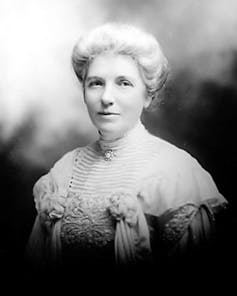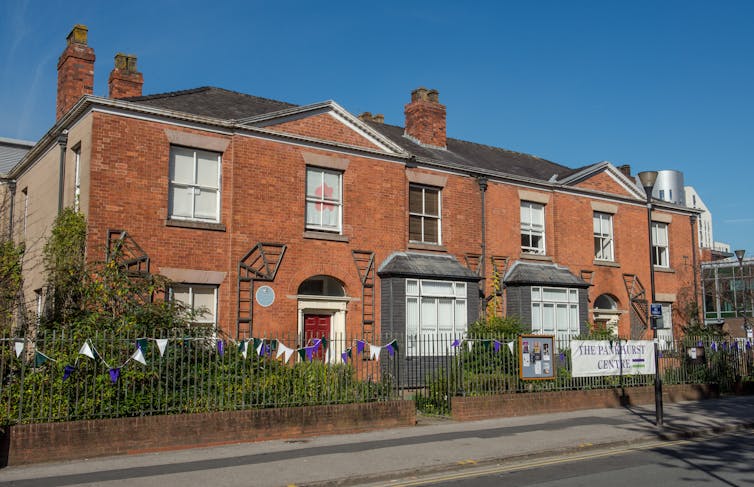The 'epicentre of women's suffrage' — Kate Sheppard's Christchurch home finally opens as a public museum
- Written by Katie Pickles, Professor of History, University of Canterbury
Kate Sheppard was around 40 in 1888, the year she and her family moved into the brand-new wooden villa at 83 Clyde Road, Ilam. Now part of inner Christchurch, it was then a rural section some five kilometres from the city centre.
Today, 132 years later, what is now known as Te Whare Waiutuutu Kate Sheppard House will be opened by Prime Minister Jacinda Ardern.
The government bought the house in 2018 to mark the 125th anniversary of women’s suffrage and its former owner’s pivotal role in the movement. The landmark property will now be open to the public as a museum promoting and and celebrating Sheppard’s life and achievements.
The feminist pioneer had migrated to Christchurch from Scotland in 1869. She married city councillor and merchant Walter Sheppard in 1871. Their son Douglas was seven when they moved into Clyde Road, which was near where her two sisters, a brother and friends already lived.
Because women were largely excluded from the male world of politics, the house served as both home and unpaid workplace. Emblematically, a domestic space was the epicentre of woman’s suffrage, birthplace of the campaign that would see New Zealand become the first country in the world to enfranchise all women, regardless of race, class or creed, on September 19, 1893.
A centre of activism
During the prime years of her activism, from 1888 until 1902, Sheppard worked in the house, writing letters, speeches and articles. It was where newspapers and books were read, ideas formed and actions plotted. Other women activists, such as Ada Wells, and male supporters Alfred Saunders and John Hall were regular visitors.
It was in the dining room that the iconic third petition, with 32,000 signatures from around the country, was pasted together and wrapped around a wooden handle for Hall to roll down the aisle in parliament. And it was where the suffrage victory was celebrated.
Read more: Why New Zealand was the first country where women won the right to vote
After 1893 the property remained a hub of feminist ideas for social change. As Sheppard later put it, there were still many “fossilised prejudices” to work on. In 1896, she became the founding president of the National Council of Women, directing activities and fostering international connections from the house.
 Kate Sheppard.
Kate Sheppard.
Sheppard worked hard, advocating for health and well-being, education and social, political and economic justice. The Married Women’s Property Act 1884 and the Divorce Act 1898 were two further important feminist victories, but it took until 1910 for the repeal of the 1869 Contagious Diseases Act, which unfairly targeted prostitutes.
Sheppard believed in women’s economic independence, their place in the professions and equal pay for equal work. She campaigned for women to be able to stand for parliament, to be appointed as justices of the peace, to act as jurors and to be guardians of children.
Despite its illustrious history, the Clyde Road house was mostly overlooked for decades. But thanks to a succession of owner-occupiers who poured love and money into the villa, it has not only survived but thrived.
John Joseph Dougall, lawyer and mayor of Christchurch from 1911 to 1912, bought the house from Walter Sheppard and undertook grand Edwardian improvements. It was further extended and modernised during the ownership of Julia Burbury and family, who for 33 years were the last private owners.
Read more: Did a tragic family secret influence Kate Sheppard's mission to give New Zealand women the vote?
Unlisted and largely unknown when Burbury bought it, the house eventually became a category one historic place in 2010. By then, a second wave of feminism had raised the status of women’s history, recovering and celebrating Sheppard and her colleagues as role models.
 The Pankhurst Centre, former home of Emmeline Pankhurst where the suffragette movement began in Manchester, England.
GettyImages
The Pankhurst Centre, former home of Emmeline Pankhurst where the suffragette movement began in Manchester, England.
GettyImages
A feminist shrine?
With the 1993 suffrage centenary and Sheppard’s likeness gracing the New Zealand $10 note, she has become a national heroine. Is her house likely to become something of a feminist shrine, too? If so, it would be part of a global trend.
In 1965, the family home of US women’s rights pioneer Elizabeth Cady Stanton in Seneca Falls, New York, became a National Historical Landmark. She lived there from 1847 until 1862, and referred to the farmhouse as the “centre of the rebellion”.
It is now part of the extensive Women’s Rights National Historical Park. Opened in 1980, it focuses on the first Women’s Rights Convention held in Seneca Falls in 1848, but claims a broad philosophical brief:
It is a story of struggles for civil rights, human rights, and equality, global struggles that continue today. The efforts of women’s rights leaders, abolitionists, and other 19th century reformers remind us that all people must be accepted as equals.
The former home of Cady Stanton’s suffrage partner, Susan B. Anthony, also became a National Historic Landmark in 1965. The celebrated American civil rights leader ran the National American Woman Suffrage Association from the house in Rochester, New York, where she lived until her death in 1906.
Today, the Susan B. Anthony Museum and House “collects and exhibits artifacts related to her life and work, and offers tours and interpretive programs to inspire and challenge individuals to make a positive difference”.
In Britain, Manchester’s Pankhurst Centre opened in 1987 as “an iconic site of women’s activism, past and present”. The home of suffragette Emmeline Pankhurst and her family from 1898 to 1907, the first meeting of the Women’s Social and Political Union (WSPU) took place in its parlour.
Keeping activism alive, the house is also a women’s centre and home to Manchester Women’s Aid, a service for victims of domestic abuse. It seeks to be a “unique and vibrant place where women can learn together, work on projects and socialise”.
With hindsight, early European feminists were reformers, but they could also be agents of colonisation. In Aotearoa New Zealand, their connections with Māori focused on temperance and they tended to assume assimilation was inevitable.
In the US and Britain the emerging feminist “shrines” have attempted to widen their remits accordingly. How Te Whare Waiutuutu Kate Sheppard House views its purpose and makes public history is a story that begins today.
Authors: Katie Pickles, Professor of History, University of Canterbury





